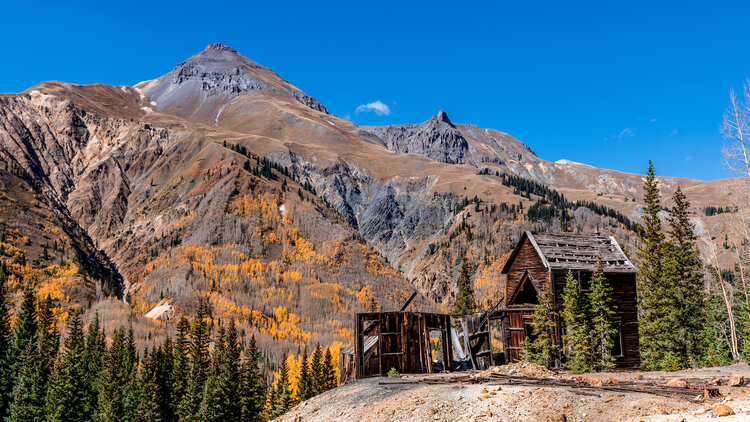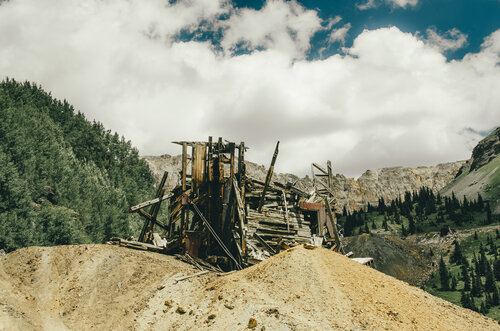Ouray County COGenWeb
COGenWeb a proud partner of USGenWeb
Ghost Towns Around Ouray
There are numerous ghost towns throughout the Ouray, Silverton, and Telluride area. Some of these former mining towns were small, inhabited by only a few people, while others had thousands of residents. Most ghost towns in the area, due to the difficult and unforgiving long winter months, are now bare sites with only a few buildings still standing. These historical ruins are “true ghosts.” You'll find shadows of the past. There are towns that can be reached by passenger car, but most are located in remote areas only accessible by four-wheel drive.

Visit these ghost towns and step back in time. Stand in ramshackle bunkhouses, once occupied by brave souls seeking fortunes. Even when you're physically there, it's difficult to imagine the hardships experienced by the individuals who once worked thousands of feet underground in cold, dirty, and dreary conditions.
In your exploration of these abandoned mine sites, be extremely cautious of any unprotected portals and shafts. Do not allow children to wander unsupervised. Please leave the sites the way you found them. Do not help in the further destruction of these sites by carrying away any pieces of their history.
The following sites are only a small fraction of those that exist in the San Juan Mountains surrounding Ouray.
Ghost Towns Accessible by Passenger Car
Camp Bird Mine
Established in 1896 by Thomas Walsh. One of the richest and most famous mines in the world, the mine produced over $26,000,000 in gold between 1896 and 1910. The mill itself was sold to a Canadian company, Mongolian Gold, in 1995. The mill was disassembled, shipped to Mongolia, and reassembled for use in a significantly smaller capacity than was the case at the Camp Bird Mine.
Red Mountain Town
Located off Hwy 550 near the crest of Red Mountain Pass—this is the site of the National Bell Mine. During its booming years, there were as many as 10,000 inhabitants living in Red Mountain Town. In all of its glory, it had over 100 businesses, a post office, jail, schools, newspapers, saloons, and gambling halls. Winters were extremely rough and only the most rugged individuals stayed. Several fires between 1892 and 1937 nearly leveled the town. However, regardless of how difficult the environment is, over thirty million dollars in gold, silver, lead, zinc, and copper has been taken out of this area. You can overlook this town site from Hwy 550 at the Idarado Mine turnoff or park your car at the Red Mountain Pass area and hike into the town site.
Ironton Townsite
Ironton, founded in 1883 at 9,800 feet elevation, is located at the north end of the Red Mountain Mining District. It was an extremely wealthy town, important as a transportation junction and a stage and supply center. The water in this area contained sulphuric acid, which ate up the metal machinery used in the mines. This was the main factor that lead to the closing of this area's mines. The population was between 800 and 1,000. This included mines and boarding houses in outlying areas. Several buildings are still standing. Through a grant providing funds for stabilization, the Red Mountain Project is currently stabilizing two of the three houses left standing in what was once the town of Ironton.
Joker Tunnel and Boarding House
Located on the Million Dollar Highway 1-1/2 miles south of the Ironton town site. It was established in 1902 for the purpose of draining water from rich mines further to the south. This beautiful boarding house stands proudly as a reminder of its past and the prosperous mining boom.
Alta
Located at 11,800 feet, off Hwy 62 south of Telluride, Alta was an active mining camp but never incorporated as a town. Its top population was 100 during the gold boom. Cabins, a boarding house, and outhouse buildings are still standing. A beautiful lake sits a short distance up the road from the site.
Animas Forks
Established in 1875 at 11,180 feet elevation, residents once boasted that Animas Forks was the largest city in the world... at this altitude. The offer of free land and help with building one’s house lured over 1,000 residents to the town. Animas Forks served many mines in the area, mainly the Gold Prince at the upper end of Placer Gulch. The town boomed in the 1870s and 1880s but was mostly deserted by the 1920s. The town was plagued by avalanches, which frequently destroyed buildings and kept travelers from entering and residents from leaving. There is currently a wide variety of buildings still standing. Thomas Walsh owned the large home with the bay window in Animas, just prior to his famous strike at Camp Bird.

Frisco Mill
This page was last updated